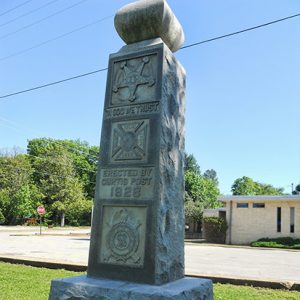calsfoundation@cals.org
Grand Army of the Republic (GAR)
The Grand Army of the Republic (GAR) was a fraternal organization for Union veterans. The first GAR posts (chapters) originated in Illinois in 1866. The patriotic organization had a surprisingly strong presence in Arkansas, a Confederate state. In the 1860s, the earliest Arkansas chapters had many African-American veterans of the Union army living in Arkansas. Toward the end of the nineteenth century, GAR chapters tended to be controlled more by white Arkansans uncomfortable with the post-Reconstruction resurgence of the Democratic Party in Arkansas.
One of the first goals of the GAR was to assist widows and orphans of fallen Union soldiers and sailors. The organization’s motto was: “Fraternity, Charity, Loyalty.” Soon after it organized, the GAR pushed for the establishment of May 30 as Memorial Day, and it was a strong advocate of the Republican Party in national elections from 1868 to 1884.
After a period of declining membership, largely due to its political efforts of the 1870s, there was a resurgence of interest in the GAR, as the American public was more accepting of secret societies (like the Masons, for example) in the 1880s than it had been immediately after the Civil War. In July 1883, Stephen Wheeler, who at that time was the clerk of Judge Isaac Parker’s court in Fort Smith (Sebastian County), helped to organize the GAR’s Department of Arkansas. The McPherson Post No. 1 in Little Rock (Pulaski County) and the Canby Post No. 102 of Hot Springs (Garland County) were among the posts that had survived the loss of interest in the 1870s. In a meeting held at Little Rock on July 13, 1883, Wheeler was elected the Grand Commander. The original officers of the GAR’s Department of Arkansas were Senior Vice Commander M. Mitchell of Little Rock, Junior Vice Commander R. E. Jackson of Hot Springs, and Adjutant General C. M. Barnes of Fort Smith. The Council of Administration members were W. W. Clayton and A. S. Fowler of Fort Smith, W. Carhart of Hot Springs, and a Dr. Owens of Eureka Springs (Carroll County). The group elected Colonel E. A. Nichols of Hot Springs and “a gentleman from Eureka Springs” to attend the national encampment in Denver, Colorado.
More than 100 GAR chapters were formed in cities and towns all across Arkansas, although this number includes chapters formed in the 1860s that were defunct by the 1880s and chapters that did not come into being until after 1880. Chapters were formed in such former strongholds of Confederate sentiment as the Delta region and southern Arkansas, as well as in the Ozark and Ouachita mountains, in which a strong Unionist outlook had prevailed during the Civil War. Little Rock had three chapters, while Fort Smith and Hot Springs each had two. Former black Union soldiers were eligible to belong to the GAR, even after the beginning of the Jim Crow era; however, Southern mores prevailed in Arkansas, and African-American veterans either met separately or not at all. Some reports indicate that fees paid by black members were not properly credited to their accounts with the GAR.
The Arkansas chapters of the GAR, like those in other states, promoted the observation of Flag Day, advocated the singing of the “Star-Spangled Banner” at civic events, and decorated the graves of Civil War veterans, especially on May 30 (called Memorial Day or Decoration Day). In 1903, despite declining membership, the GAR and its women’s auxiliary, the Women’s Relief Corps, decorated 2,390 graves, gave twelve speeches, and involved 340 school children in patriotic activities on Memorial Day.
Across the country, the GAR also erected monuments commemorating the war and its victims. Although the state of Arkansas has a multitude of Confederate monuments, the GAR is known to have erected only three in the state. The first was placed at the Evergreen Cemetery in Judsonia (White County) in 1894. It is an obelisk marker surrounded by the graves of sixteen Union soldiers. The GAR monument in Gentry (Benton County) was dedicated in 1918. The third was unveiled in Siloam Springs (Benton County) in 1928. It stands at the south end of Twin Springs Park. The monuments in Judsonia and Siloam Springs were listed on the National Register of Historic Places on May 3, 1996. The Gentry Grand Army of the Republic Monument was listed on the National Register of Historic Places on January 26, 2018.
The last GAR chapter in the United States folded in 1949 due to the lack of surviving veterans. It is not known when the last GAR chapter in Arkansas was closed.
For additional information:
“The Grand Army of the Republic and Kindred Societies.” Library of Congress. http://www.loc.gov/rr/main/gar/ (accessed February 7, 2022).
Logan, Charles Russell. “Something So Dim It Must Be Holy: Civil War Commemorative Sculpture in Arkansas, 1886–1934.” Little Rock: Arkansas Historic Preservation Program, 1997. Online at https://www.arkansasheritage.com/arkansas-preservation/programs/publications (accessed April 18, 2024).
Staff of the CALS Encyclopedia of Arkansas


 GAR Application
GAR Application  GAR Application
GAR Application  GAR Gathering
GAR Gathering  GAR McPherson Post No. 1
GAR McPherson Post No. 1  GAR Monument
GAR Monument  GAR Monument, Siloam Springs
GAR Monument, Siloam Springs 



I found this article in the Library of Congresss news articles section when researching a cemetery in Hot Springs:
St. Louis Republic, May 27, 1901; Memorial-Day Services.; Graves of Blue and Gray Decorated in Arkansas.; Republic Special. Hot Springs, Ark., May 26The graves of both the Union and Confederate dead were decorated to-day under the auspices of the Grand Army of the Republic. An invitation was extended to all visiting comrades, to the United Confederate Veterans, Daughters of America, to the soldiers of the Spanish-American and Phillippine wars and to the officers and inmates of the Army and Navy Hospital.; About 1,000 people attended the services, which were of an exceedingly interesting character. The weather was beautiful, and flowers were in the greatest abundance.